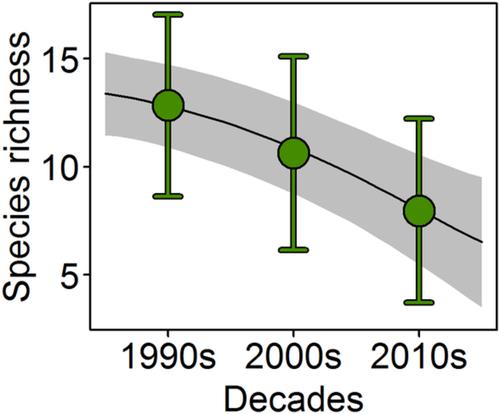当前位置:
X-MOL 学术
›
Insect Conserv. Divers.
›
论文详情
Our official English website, www.x-mol.net, welcomes your
feedback! (Note: you will need to create a separate account there.)
Long‐term monitoring reveals decreasing water beetle diversity, loss of specialists and community shifts over the past 28 years
Insect Conservation and Diversity ( IF 3.2 ) Pub Date : 2020-03-04 , DOI: 10.1111/icad.12411 Nicolas Roth 1, 2, 3 , Sebastian Zoder 4 , Assad Ali Zaman 4 , Simon Thorn 1 , Jürgen Schmidl 4
中文翻译:

长期监测发现,在过去28年中,水甲虫的种类不断减少,专家的流失和社区转移
更新日期:2020-03-04
Insect Conservation and Diversity ( IF 3.2 ) Pub Date : 2020-03-04 , DOI: 10.1111/icad.12411 Nicolas Roth 1, 2, 3 , Sebastian Zoder 4 , Assad Ali Zaman 4 , Simon Thorn 1 , Jürgen Schmidl 4
Affiliation

|
- Lentic freshwater organisms are influenced by a multitude of factors, including geomorphology, hydrology, anthropogenic impacts and climate change. Organisms that depend on patchy resources such as water beetles may also be sensitive to anthropogenic habitat degradation, like pollution, eutrophication, water level or management alteration.
- To assess composition and ecological trends in the water beetle communities of Central Europe, we sampled water beetles (Dytiscidae, Haliplidae, Noteridae) in 33 water bodies in Southern Germany from 1991 to 2018. We used manual, time‐standardised capture during three periods: between 1991 and 1995, 2007 and 2008, and 2017 and 2018.
- During the 28‐year survey period, we captured a total of 81 species. We found annual declines in both species number (ca −1%) and abundance (ca −2%). Also, community composition showed significant changes over time. The significant impact of pH on the community composition suggests that the recorded changes through time partly reflect natural succession processes. However, a pronounced decline of beetle species belonging to the moor‐related beetle associations indicated that Central European water beetles are also threatened by non‐successional factors, including desiccation, increased nitrogen input and/or mineralisation, and the loss of specific habitats. This trend to physiographical homogenisation resulted in corresponding community composition shifts.
- To effectively protect endangered species, conservation strategies need to be aimed at regularly creating new water bodies with mineralic bottom substratum, and maintenance of moor water bodies that represent late successional stages.
中文翻译:

长期监测发现,在过去28年中,水甲虫的种类不断减少,专家的流失和社区转移
- 透镜状淡水生物受到多种因素的影响,包括地貌,水文学,人为影响和气候变化。依赖于斑驳的资源(例如水甲虫)的生物也可能对人为的栖息地退化(例如污染,富营养化,水位或管理变更)敏感。
- 为了评估中欧水甲虫群落的组成和生态趋势,我们对1991年至2018年德国南部33个水体中的水甲虫(Dytiscidae,Haliplidae,Noteridae)进行了采样。我们在三个时期内使用了手动的,按时间标准化的捕获方法: 1991年至1995年,2007年至2008年以及2017年至2018年。
- 在28年的调查期内,我们共捕获了81种。我们发现物种数量(ca -1%)和丰度(ca -2%)均逐年下降。此外,社区组成随着时间的推移显示出重大变化。pH值对群落组成的重大影响表明,随着时间的推移记录的变化部分反映了自然演替过程。但是,属于与沼气相关的甲虫协会的甲虫种类明显减少,这表明中欧水甲虫还受到非成功因素的威胁,包括脱水,增加的氮输入和/或矿化以及特定生境的丧失。生理上同质化的趋势导致相应的社区组成转移。
- 为了有效地保护濒临灭绝的物种,保护策略的目标应是定期创建具有矿质底部底层的新水体,并维持代表后期演替阶段的沼泽水体。











































 京公网安备 11010802027423号
京公网安备 11010802027423号